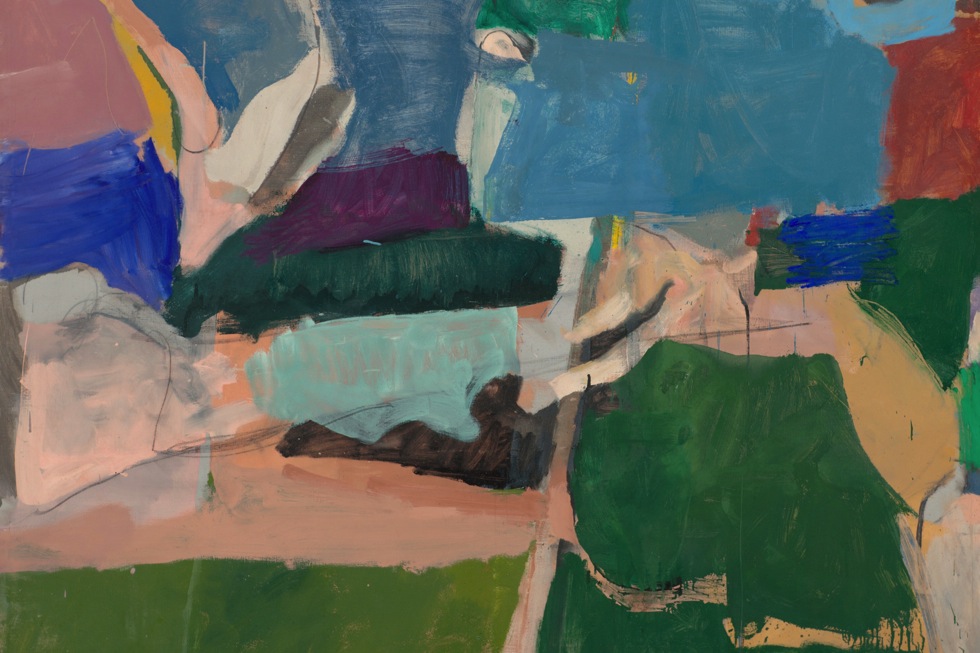Immediate And Alive: Richard Diebenkorn At The Royal Academy

Katherine April Caddy finds herself captivated by the smaller, wilder works of an artist who enjoyed making colour a stranger to us…
I knew little about Richard Diebenkorn before attending his retrospective at the Royal Academy last week. Through reading a series of articles and seeing pictures of Diebenkorn’s ocean parks, I grew fascinated by the artist’s life story and work, and couldn’t miss the show. Strangely, the towering architectonic images I felt most drawn to when researching on screen did little for me in the flesh; I was captivated instead by the painter’s smaller and wilder early works.
Diebenkorn is revered as one of America’s greatest abstract expressionist painters, having been an instrumental figure during the early years of the Bay Area Figurative Movement, with a prolific post-war career spanning four decades. The RA’s retrospective — the first solo airing of Diebenkorn’s work since 1991 — offers exciting glimpses of three key stages of the artist’s career: early abstraction, figurative work, and the ocean parks of the painter’s later years.
As a young man, Diebenkorn gained recognition as a leading West Coast abstract painter. His Berkeley series — a collection of over 50 semi-abstract, vibrant landscapes — was formed close to graduating from the University of New Mexico during the early 1950s. These are dazzling, energetic paintings that are refreshingly unfussy. We can see the new artist’s keenness to experiment within them. Diebenkorn entices us to revel in abstraction through enlivening blues, wholesome greens and familiar, comforting nude shades. Gazing at Berkeley #57, I felt all was in motion – that I was looking at strange fields from above – gasping pinks, odd yellows and almost-neon oranges made looking away difficult. The work catches you off-guard, draws you in, and asks you to stay a while – to simply enjoy the paint and the moment, which is neither serene nor frenzied – it is bountiful, warm and Californian.
Within this early series earthy colours dominate, while pastels and intense vibrant shades are dashed – they whisper or sit – sometimes scrubbed away and made fuzzy. White escapes from behind the brighter areas and nothing is made absolute. A young Diebenkorn seems to have enjoyed making colour a stranger to us. In Berkeley #41, vague and uncomfortable shades of green are juxtaposed with scrubby purple, while nude blocks add texture. Black paint looms and lingers; thick lines and a whole brush of black feature in one corner of the work, breaking chances of this being a quiet, merely sunny, western landscape.
While I enjoyed the Berkeleys, they were forgotten when I encountered an untitled drawing created by Diebenkorn in 1954, using graphite, coloured pencil, crayon and watercolour on paper. Perhaps I found this so exciting because I have been experimenting with drawing for the first time recently, and this piece seemed so enthusiastic, tender and alive. Here, pastels prevail while black aspects dart across the paper – certain and sudden. Diebenkorn’s drawings are not studies or preparatory pieces – they are works in their own right, and they sing of confidence and new ideas.
Diebenkorn’s Seawall of 1957 is much celebrated, and I can see why. This piece is immediate; it is alive, there is definitely a sense of motion and of a breath of air through its beautiful thick blue and green oils. Here we see the artist moving away from abstraction, carving out a coastal scene in pastels and deep shades, celebrating the capacity of his palette. In one area the scene is interrupted by the artist, who appears to have scraped away the corner of the hillside with the end of his brush – a sure reminder of firm control over the direction of his work.
In 1961, Diebenkorn created a figural painting entitled Head, in oil on canvas. There is a sadness and solitude to this piece; a gentleness and sense of quietude. A female is bathed in light, her head dominating, while the green of her blouse is echoed in her face, eagerly marking shadows. This work came across as soulful and dignified to me, and once home I discovered that the artist enjoyed painting women with their heads lightly facing downwards throughout the 1960s. Diebenkorn spent this decade towing the line between abstraction and representation, as evidenced by his untitled, invented landscape of 1966. This work on paper, an abundance of blue, green, yellow and white, presents what may be described as a lollypop tree and a small estuary – a path of homeward-bound water that from afar I mistook for a shadowy lone figure. This place is a dream world, a beautiful and fresh safe space; perhaps an imagined utopian haven.
The third room contains the ocean parks. These are broadly Diebenkorn’s most acclaimed works – non-objective, pastel and tidy, playing with our perception of flatness through hints of graphic, painterly depth. They are what he is renowned for and are held by many of America’s top galleries and museums. Ocean Park #116 was created with oil and charcoal and spoke to me of wide open water and rows of block pastel urban dwellings. Here, all is fading, bleaching, and ultimately maintained and controlled. The ocean parks are large, poised, and all the more beautiful when seen in miniature, painted on cigar boxes as gifts from the artist. When the parks are scaled down and at eye-level, their brilliance is exclamatory, and the artist’s hand is made ever-present.
Katherine April Caddy
See Richard Diebenkorn at the Royal Academy, London, until 7 June 2015. Open daily 10am-6pm (Friday 10am-10pm). Admission £10, concessions available
Image: Richard Diebenkorn, Berkeley #5, 1953. Oil on canvas, 134.6 x 134.6 cm. Private collection. Copyright 2014 The Richard Diebenkorn Foundation





